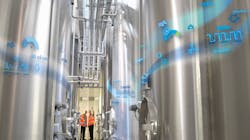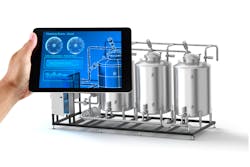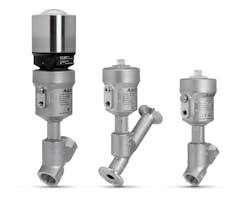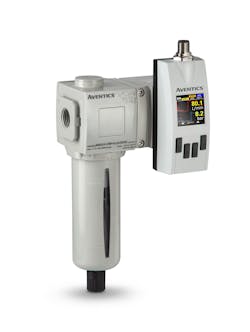Beyond automation: Improving CIP sustainability and productivity using in-depth analytics
The clean-in-place (CIP) systems food and beverage processors use to internally clean equipment between batches help ensure product quality and safety as well as regulatory compliance. However, many inefficiencies can exist within these systems that can affect a processor’s environmental impact and production levels.
CIP operations use nearly 30% of a plant’s utilities, but it is often unknown exactly how much energy and media each cleaning cycle consumes. Cleaning cycles also typically run for a preset amount of time that may be longer than required for proper cleaning, and a significant amount of time is spent in changeovers. This level of uncertainty and guesswork introduces the chance that processes use more resources and time than they need, resulting in wasted energy, water, steam, chemicals and many thousands of dollars in downtime.
Checking and reporting makes it possible for food and beverage processors to gain some control over their CIP processes and address possible excess, as well as comply with regulations. Many plants take a manual approach to checking and reporting, which can incur between $20,000 to $40,000 in labor costs and invite the margin of error that accompanies pencil-and-clipboard recording. Some plants have begun to automate parts of their CIP operations by incorporating devices that can provide time- or sensor-based cleaning. While basic monitoring and control can improve system efficiency, it does not automate labor-intensive reporting or provide analytics that can clarify utility consumption, and it does not reliably improve sustainability.
However, a new CIP utilities and reporting solution combines sensor-equipped devices like pressure regulators and valves with CIP software to capture and analyze critical process data. This sophisticated tool goes beyond automating the reporting process to provide advanced analytics about CIP operations that can help food and beverage processors meet broader, enterprise-wide sustainability and production goals. By tracking utilities, generating automated reports and comparing each cycle against an ideal-golden CIP, the CIP solution can help manufacturers improve reporting accuracy, reduce water consumption by 20% to 35% and save up to 20% of their time managing manual and semi-automated systems.
Reducing utilities waste
At a time when manufacturers across all industries are making ambitious water conservation and net-zero goals, there is no room to use more energy, water and other resources than processes require. To reliably meet sustainability goals, it is imperative that food and beverage processors prevent utilities waste as much as possible. One primary way to do this is by monitoring trends to optimize overall resource and energy consumption.
To understand the impact that this new digital solution can have on the sustainability of CIP processes in food and beverage manufacturing, consider a manual or sub-optimized CIP system in a brewery or dairy. A batch tank is connected to a water supply line and a series of cleaning supply tanks that contain media such as disinfectant, acid, caustic and reused water. Each media tank pumps a process fluid into the batch tank in a sequence according to the cleaning protocol until the timed cycle is complete and the tank is considered clean and ready for the next batch.
Despite the simplicity of this configuration, the operator who oversees the CIP system often does not know how much media is being consumed during each timed cleaning cycle. The operator monitors and fills the supply tanks and makes manual adjustments to flows, but the specific volume of media being used per wash cycle is often unknown, creating an opportunity for untracked waste.
To reliably track resource-use, the new CIP utilities and reporting solution provides monitoring via sensors that gather critical process data, including air, water, steam, chemicals and energy, in real time while the software receives and analyzes that data and presents it in report form. The collected data is delivered to an edge device where data is collected for local analysis and potentially forwarded to an enterprise-level system or the cloud.
With access to real-time process information via analytics software, which is available through automatic report generation, manufacturers are equipped to automate and optimize wash cycle settings, including cycle duration and media use, for optimal efficiency and maximum productivity. They also have the option to take the data and analytics further into enterprise-wide systems.
Test skids have demonstrated how water, acid, detergent and reclaim can be optimized during a CIP cycle to reduce water consumption by 30% to 45%, as well as reducing 20% of the time operators spend at the CIP station. This significant reduction in operator time alone represents a savings of $20K to $40K annually, and it can help to alleviate the pressures of a stretched workforce within the industry.
Improving production and visibility
While CIP processes are essential to production, they take time away from creating product. It is critical that the process is as efficient as possible while providing cleaning effectiveness. One way to do this is to determine utilities and cycle effectiveness across single or multiple sites by benchmarking CIP cycles.
The cleaning cycle may run for a preset amount of time deemed sufficient for cleaning, but if no sensors or metrics are in place, then waste is likely occurring during the cycle. The cycle may be running much longer than is necessary to properly clean the tank and ready it for the next batch, and this extra cleaning time results in several operating costs that may exceed actual requirements. One is the cost of production downtime while the batch tank is offline during the cleaning cycle and cannot be used. Another is the extra energy being used during a longer-than-necessary wash cycle time. And still another is the additional water and media being consumed beyond what is needed to effectively wash the tank.
The CIP software makes it possible to generate a “golden batch” score that represents the ideal benchmarks of a cycle running at optimal efficiency. Automated reports can then be set up to compare each wash cycle’s utilities consumption to the “golden batch” to track process improvements. Reports can also ensure that appropriate stakeholders are able to monitor key CIP parameters in real time, as well as improve traceability and visibility for one or many systems. The overarching goal of the entire system is resource efficiency, with resources including energy, water and media as well as personnel, and the results so far have demonstrated noteworthy improvements in every resource category.
Test skids have demonstrated how shorter cycle times result in up to 50% faster changeovers. Instead of using a timed cycle, sensors and software can tell the operator when the cleaning cycle is complete. This delivers a huge benefit for manufacturers in terms of conserving media usage and reducing overall energy consumption. Shorter cycle times also get batch tanks back online faster, thereby increasing uptime and improving productivity.
Minimizing reporting time with greater accuracy
Yet another common inefficiency and hidden cost within a CIP system is when an operator is manually logging process data like cycle times, pressures and temperatures and completing routine system reporting on paper. This pencil-and-paper approach not only requires time for the operator to capture the data for reporting, it also adds opportunities for human error during the recording process. These errors can then be transferred to other types of record keeping and documentation, further magnifying the problem.
Digitalization of CIP systems eliminates pencil-and-paper record keeping and replaces it with software capable of instantly converting process data into organized reports. Reports can be generated for satisfying government regulation and compliance requirements, planning system maintenance, scheduling downtime and ordering media supplies. Instead of an operator reading and manually recording data throughout a wash cycle, that data can be captured digitally, and reports can be delivered as a PDF file to the operator’s inbox and shared with other stakeholders, including sustainability officers. Deeper analytics available with the software can also reveal insights and trends that support predictive maintenance schedules and facilitate standardization of CIP processes across multiple facilities.
Helping every plant achieve its goals
While many suppliers offer CIP hardware and sensors, few have taken the extra steps to apply the available data to the kinds of deep analytics that can fully unlock the advantages of digitalization to improve sustainability and productivity. Even fewer have done so in a way that allows manufacturers to pick and choose how they access the process data and whose components they use to make that data available.
System-agnostic, the CIP software is designed to connect to existing or additional sensors and smart devices, allowing manufacturers at any stage of digital transformation to receive significant benefits without committing to all-new, brand-specific components. Manufacturers can integrate any or all elements, including the sensors, controller or edge device and analytics for visualization, and customize it for their needs. This level of flexibility gives manufacturers of all sizes the power to decide where and how they enter the digitalization process.
The range and depth of analysis and reporting the CIP software provides, including energy and utility usage trends, media trends, traceability and regulatory and compliance reporting, allow manufacturers to realize valuable benefits beyond the cleaning process itself. The latest CIP utilities and reporting software go beyond basic monitoring and control, to deliver the advanced analytics that give food and beverage producers the tools to optimize their processes, achieve smarter operations and reliably reach broader, enterprise-wide sustainability and production goals.
Jennifer Williams is product marketing manager, Hybrid Markets at Emerson.
About the Author
Jennifer Williams
Product marketing manager, hybrid markets at Emerson
Jennifer Williams is product marketing manager, Hybrid Markets at Emerson.





